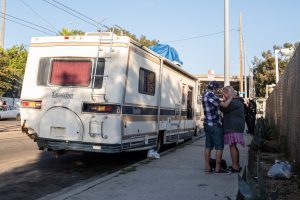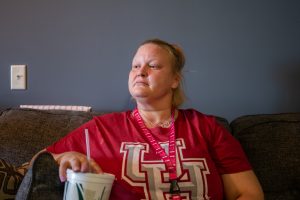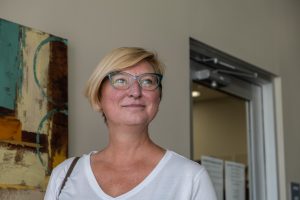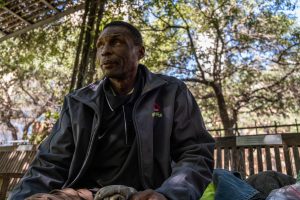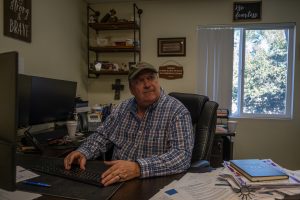- Slug: BC-CNS-Homeless Funding – Houston, San Diego, 3000
- 9 photos available (thumbnails and captions available below)
- 1 data visualization available here
By Audrey Jensen, Jill Ryan, Chloe Jones and Madeline Ackley
Howard Center for Investigative Journalism
HOUSTON — Nearly a decade ago, two U.S. cities with large homeless populations tried to solve their problem by adopting a strategy that prioritized giving people housing and help over temporary shelter.
But Houston and San Diego took fundamentally different approaches to implementing that strategy, known as Housing First. Houston revamped its entire system to get more people into housing quickly, and it cut homelessness by more than half. San Diego attempted a series of one-off projects but was unable to expand the lessons learned and saw far fewer reductions in homelessness.
Despite those outcomes, the cities are again charting different paths in deciding how to use millions in taxpayer money that Congress approved to care for the homeless as part of the Coronavirus Aid, Relief and Economic Security Act.
Each city has been allocated more than $26 million in federal emergency funds to protect and house their homeless populations, among the most vulnerable to the coronavirus. In keeping with Housing First, Houston is focusing much of its unprecedented amount of aid on permanent housing and homeless prevention. San Diego, with its chronic shortage of affordable housing, is prioritizing temporary shelters.
Housing First was a revolutionary idea when it was introduced in the 1990s because it didn’t require homeless people to fix their problems before getting permanent housing. Instead, its premise — since confirmed by years of research — was that people are better able to address their individual problems when basic needs, such as food and a place to live, are met.
“It was a change in direction from how the initial response to homelessness was thought about and structured,” said Matthew Doherty, the nation’s former homelessness czar. “It puts a lot of responsibility on communities and on organizations to really understand what their clients need and want, and to really center people in the processes for deciding how to help.”
Housing First became the guiding principle for homeless programs led by the U.S. Department of Housing and Urban Development, which created financial incentives for communities that followed that approach.
But it was not without criticism and controversy, which is why Congress included wording in the CARES Act that barred any of the $4 billion in pandemic homeless aid from being used “to require people experiencing homelessness to receive treatment or perform any other prerequisite activities as a condition for receiving shelter, housing, or other services.”
Ann Oliva, a former HUD official, said that was a “specific nod” to the Trump administration, which has openly opposed Housing First.
Doherty said federal leadership needs to be clear when “leading the efforts to prevent and end homelessness across the country” and to embrace this role “fully rather than as a temporary investment of time and effort.”
‘What could Houston do better?’
Mindy Johnson, who is a survivor of sex trafficking, hasn’t had stable housing for nearly two decades. She arrived in Houston in 2003 and since then has moved in and out of temporary shelters.
In October, Johnson got a place to live and supportive services from Houston’s homeless system. She said she still struggles with alcohol addiction, but sees a therapist and caseworker on a regular basis.
“What could Houston do better? They can’t,” said Johnson, 41. “Houston has helped me more than anybody in this world. It brings me to tears.”
In 2011, the Houston area had one of the highest homeless populations in the country, with more than 8,400 people without stable housing. By January 2020 that number had decreased by about 55% to around 3,800, according to the latest government homeless census. The city had earlier ended its U.S. veteran homelessness by combining local, state and federal resources to house 3,650 veterans over a three-year period, according to government data.
Experts attribute the success to a systemwide effort to coordinate homelessness responses across the Houston area, following the Housing First principles of providing housing and services for people without mandatory prerequisites.
Houston started its system revamp after it was deemed a “priority community” by HUD in 2011. The city had been underperforming, said Eva Thibaudeau-Graczyk, former chief program officer for the nonprofit Coalition for the Homeless in Houston and Harris County.
“Our funding was not going to go up if we didn’t really take seriously this HUD technical assistance that we were getting,” she said.
The system was disjointed, with service gaps, duplicative services and people being passed around instead of being directed toward housing, said Marilyn Brown, the coalition’s former chief executive.
“Somebody could be feeding lunch at one corner and, right across the street, feeding lunch as well. Nobody was looking at duplication of services or where gaps in services were based on geography, [and] you know funding,” Brown said.
Each provider acted as a jack-of-all-trades, undercutting efforts to reduce homelessness, Thibaudeau-Graczyk added.
SEARCH, a nonprofit that connects people on the streets with housing, was a prime example. Prior to the system overhaul, SEARCH offered a laundry list of services inside its headquarters.
“We had financially overextended because we were trying to do all these things: employment program, food program, housing,” said Thao Costis, SEARCH’s current chief executive who’s been with the nonprofit for 25 years.
The “priority community” designation brought in Mandy Chapman Semple, a HUD-appointed consultant. In 2012, she helped design a new strategic plan to end homelessness and was eventually hired as a special assistant to the Houston mayor for homeless initiatives.
“When you get a champion, like a Mandy, involved, who really understands every aspect of homelessness, and understands the funding sources and mechanisms to allow you to succeed and helps you develop good data, that can make a huge difference,” said Neal Rackleff, former director of Houston’s Housing and Community Development office.
Collaboration has been integral to the Houston area’s success, experts say. A homeless governing structure made up of representatives from local government, nonprofits and other constituencies was created to try to ensure funding was invested according to Housing First principles.
According to Thibaudeau-Graczyk, when local funders were educated on the benefits of Housing First and “changed what they were willing to fund, then the providers changed how they were doing services.”
Support from Houston’s last two mayors — Annise Parker and Sylvester Turner — also helped balance long-term homeless responses with short-term political goals.
Houston has housed over 18,000 formerly homeless people in the area since the revamp began, according to the coalition and Thibaudeau-Graczyk. It did this by increasing the amount of permanent housing through developing new properties, renovating old buildings and giving landlords incentives to accept rental assistance. It also offered voluntary treatment services.
Sam Tsemberis, a clinical psychologist who first developed the Housing First strategy as a mental health program in New York City in the 1990s, said “it’s housing first, but not housing only.”
And it’s not a panacea. “If you run the program well,” he said, “you will have an 80 or even 90% success in ending homelessness. You still have 10 or 20% of the people who don’t make it in Housing First, and for this group we need a different approach.”
Take 43-year-old Jonathan Davis-Turner. Homeless for most of the last 13 years, he spent time in a psychiatric hospital after suffering a manic episode and was released back to the streets on Nov. 3. Davis-Turner takes medication used to treat bipolar disorder and schizophrenia, which makes independent living difficult — even with ongoing support services.
“Homelessness, that made me crazy, man,” he said. “I just do whatever this little voice tell me to do in my head. I can’t help it.” He currently sleeps each night outside The Beacon, a day shelter that also serves as one of the city’s homeless housing coordination centers.
The resilience of Houston’s system was tested when homelessness increased by almost 15% after Hurricane Harvey in 2017. While some of those increases have been reversed, Houston has not yet recovered to where it was before the storm, said Catherine Troisi, an epidemiologist at The University of Texas Health Science Center, who verifies the annual homeless count. She’s expecting to see a COVID-19-related increase in the area’s next homeless count in January.
Houston and surrounding Harris County have decided to use part of the unprecedented amount of federal homeless aid to help launch a two-year housing initiative. The $65 million Community COVID Housing Program will offer rental and other assistance to prevent homelessness; identify and house those experiencing homelessness because of the pandemic; and create more long-term housing options with supportive services available.
Houston will spend just over 40% of its $28.9 million in emergency homeless relief aid on the program, said Melody Barr, Houston’s deputy assistant director of public services. The rest will come from other city revenue, the county and local philanthropies, according to the mayor’s office.
The new program, which involves local providers and government agencies, expects to house nearly 5,000 people by 2022, with the goal of eliminating chronic homelessness in the city of Houston and Harris County.
“It’s basically our homeless services on steroids,” Barr said.
The remainder of Houston’s homeless funding will be used to improve existing shelter and housing services, outreach amid the pandemic, and to support staff.
Experts say that homeless systems can remain successful only if they get continual financial investment, regular data analysis and ongoing coordination among stakeholders.
“This is not a problem you solve, turn the key and walk away,” said Brown, the former chief executive of Houston and Harris County’s homeless coalition.
A very different journey
Over the last decade, San Diego embarked on a very different journey, launching a series of one-off projects — some modeled on Housing First principles. Compared to the 55% decline in homelessness in the Houston area since 2011, the number of homeless people in the San Diego area has decreased just 19%, to about 7,700, according to the latest official homeless census.
San Diego’s handful of Housing First initiatives were successful in housing more than 1,000 homeless people, records showed. And, according to one study, millions in taxpayer dollars were saved compared to taxpayer-funded services frequently used by the homeless.
But San Diego did not fully apply the lessons learned, said Doherty, the former administration official in charge of the nation’s homelessness efforts.
“Historically, the community had several different start-stop experiences with expanding Housing First practices, with several initiatives to pilot or test stronger practices at a small scale, which demonstrated strong results, but those lessons and practices were then not applied to the response to homelessness more fully,” Doherty said.
Similar to Houston before its overhaul, San Diego operated “without a strategic plan to guide its spending decisions, organizational structure, and overall strategy,” according to a city audit in February 2020. Without such a strategy, city leaders and providers weren’t able to unify around a Housing First vision.
In the past, the city focused its funding on emergency shelters and caring for homeless people with disabilities. From 2010 to 2018, San Diego spent more than $62 million on permanent supportive housing and more than $30 million on shelters, city budgets show. However, from 2015 to 2018, the San Diego area had one of the highest percentages on the West Coast of people returning to homelessness after two years, and the length of stay in emergency shelters also increased.
In 2017, the city created three short-term, or bridge, shelters after a hepatitis A outbreak spread through the unsheltered homeless community. Outside consultants hired to evaluate the program later said that while the goal was to provide short-term shelter and services that could eventually lead to permanent housing, these shelters lacked adequate staffing, training and resources and were not a successful bridge. Only 8% of homeless clients moved on to permanent housing, the 2018 report by Focus Strategies found.
“We’ve placed very little emphasis on the real solution, which is more housing opportunities,” Michael McConnell, a longtime homeless solutions advocate and critic of the city’s efforts, said in an interview. “Meanwhile, we’ve built a system that just rotates people through homelessness over and over and over.”
Keely Halsey, chief of homelessness strategies for San Diego, said the city had a “pretty strong commitment locally to the Housing First philosophy” and had done “a really good job of providing service, dollars, and building up programs.”
Experts say part of the problem was misunderstanding about what constitutes a Housing First approach.
When HUD adopted the model, Tsemberis said, it “didn’t actually spell out all of the things that Housing First programs needed: the level of staffing, the frequency of support or any of that.” And while HUD made tools and training available to homeless service providers, there wasn’t much oversight of local programs.
Doherty said he and other national leaders hadn’t done a good enough job of communicating what Housing First is “clearly, succinctly, in a way that can counter the misrepresentations or the misinformation.”
Critics of Housing First, however, believe the principle — not its implementation — is flawed.
Chris Megison, president and chief executive of Solutions for Change in north San Diego County, says Housing First has been around for years, and he has not seen any significant results. The nonprofit believes in sobriety before housing and provides a range of supportive programs focused on well-being, workforce development and community service.
Megison believes the best way to address homelessness is to treat its “root causes” — dependency including substance abuse, mental illness, domestic violence and trauma. Otherwise, he says, homeless people get caught in an endless cycle of services and shelters that provide temporary assistance but fail to prepare them for self-sufficiency. However, to continue qualifying for state funding Solutions for Change recently removed its requirements for sobriety and regular drug testing at most of its housing sites, reducing the number of families served in its sober living program from 200 to 60, an organization spokeswoman said.
Pushback to Housing First has played out on the national stage, as well.
An October report from the Interagency Council on Homelessness, led by Trump appointee Robert Marbut, argued that the federal government’s policy shift to prioritizing Housing First as “a one-size-fits-all approach has not worked to reduce homelessness for all populations and communities.” The report instead called for greater attention to mental health and the dignity of work.
Tsemberis said that attitude was outdated and based on the belief “that somehow we have to fix people who are homeless rather than fix the structural problems that are creating homelessness.”
In San Diego, those structural problems are largely a lack of affordable housing compared to current wages and public assistance. Officials estimate San Diego will need more than 2,600 permanent housing units for its homeless residents over the next 10 years.
A 2019 city report said there was not enough affordable housing for people living at or below 30% of the area median income, the level needed to accommodate people experiencing homelessness. The average wait for rental assistance from the San Diego Housing Commission, the city’s housing authority, was 10 years.
Craig Curry said he has been on the waitlist for housing assistance since 2011. His $682 monthly Social Security check doesn’t cover an apartment in San Diego, where the median rent is $2,035. He ended up on the streets, he said, after his apartment building was sold and his roommates found another place to live.
“I found myself in a position that I never thought that,” Curry paused, “that me personally would be in.”
For now, San Diego plans to spend the majority of its $26 million in emergency homeless aid to reopen and improve temporary bridge shelters that were closed at the start of the pandemic because they had insufficient staff and could not meet social distancing guidelines set by the Centers for Disease Control and Prevention.
Shelter residents relocated to the city’s convention center, which has about 1,500 beds. The center offers 24-hour security, meals, laundry services, case management and housing placement services, becoming a one-stop shop for connecting homeless people to housing options and supportive services, according to a city report. Funding for the convention center housing operation ends in December.
Many of those staying at the convention center qualified for permanent supportive housing, which targets high-needs individuals who would have trouble staying housed without support services such as doctors, therapists and social workers. As of late September, about 400 people had been housed, according to a city report in November. But some ended up in temporary housing, safe havens or treatment centers.
The San Diego Housing Commission used other pandemic relief funds from the state to purchase two Residence Inn hotels that can provide up to 400 people with permanent housing. The hotels include rooms with kitchens, separate spaces for kids to study and outdoor play areas. Reminiscent of Housing First principles, the city is spending $1.2 million in pandemic homeless funds to provide “wraparound supportive services” and “rental subsidies.”
The hotels are in line with a new, long-term homelessness plan the city adopted in 2019 after it hired the same nonprofit that helped Houston overhaul its homeless services system. The strategic plan promises to “refresh the City’s Housing First system orientation.”
This November, the city elected a new mayor, Todd Gloria, who ran on a Housing First platform; his opponent campaigned against it.
In their review of San Diego’s homeless problem earlier this year, city auditors said there had been “significant efforts” to address homelessness, but lack of strategic planning rendered them “ineffective.” Auditors recommended increasing the amount of permanent housing and a review of city-owned land to see how it might be used to support further development.
“Given the severity of the homeless crisis and the City’s goal to end it,” the report said, “it is extremely important that the City continue to explore and pursue creative solutions.”
Reporter Helena Wegner contributed to this story, which was produced by the Howard Center for Investigative Journalism at Arizona State University’s Walter Cronkite School of Journalism and Mass Communication. The Howard Center is an initiative of the Scripps Howard Foundation in honor of the late news industry executive and pioneer Roy W. Howard. For more see azpbs.org/homelessfunding.
^__=
